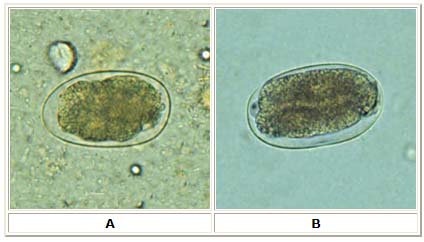Hookworm infection

Editor-In-Chief: C. Michael Gibson, M.S., M.D. [1]
Diagnosis
Laboratory Diagnosis:
Microscopy:

Microscopic identification of eggs in the stool is the most common method for diagnosing hookworm infection. The recommended procedure is as follows:
- Collect a stool specimen.
- Fix the specimen in 10% formalin.
- Concentrate using the formalin–ethyl acetate sedimentation technique.
- Examine a wet mount of the sediment.
Where concentration procedures are not available, a direct wet mount examination of the specimen is adequate for detecting moderate to heavy infections. For quantitative assessments of infection, various methods such as the Kato-Katz can be used.
A, B: Hookworm eggs examined on wet mount (eggs of Ancylostoma duodenale and Necator americanus cannot be distinguished morphologically).
Diagnostic characteristics:
- Size 57 to 76 µm by 35 to 47 µm
- Oval or ellipsoidal shape
- Thin shell
The embryo in B has begun cellular division and is at an early (gastrula) developmental stage.
Examination of the eggs cannot distinguish between N. americanus and A. duodenale. Larvae can be used to differentiate between N. americanus and A. duodenale, by rearing filariform larvae in a fecal smear on a moist filter paper strip for 5 to 7 days (Harada-Mori). Occasionally, it may be necessary to distinguish between the rhabditiform larvae (L2) of hookworms and those of Strongyloides stercoralis.
Risk Stratification and Prognosis
The most serious results of hookworm infection are the development of anemia and protein deficiency caused by blood loss. When children are continuously infected by many worms, the loss of iron and protein can retard growth and mental development, sometimes irreversibly. Hookworm infection can also cause tiredness, difficulty breathing, enlargement of the heart, and irregular heartbeat. Sometimes hookworm infection is fatal, especially among infants.
Treatment
In countries where hookworm is common and reinfection is likely, light infections are often not treated.
Pharmacotherapy
In the United States, hookworm infections are generally treated with albendazole. Mebendazole or pyrantel pamoate can also be used.
Primary Prevention
Do not walk barefoot or contact the soil with bare hands in areas where hookworm is common or there is likely to be feces in the soil or sand.
References
- http://www.cdc.gov/ncidod/diseases/submenus/sub_hookworm.htm
- http://www.dpd.cdc.gov/dpdx/HTML/Hookworm.htm
- http://www.cdc.gov/healthypets/diseases/hookworm.htm
- http://www.cdc.gov/ncidod/dpd/parasites/hookworm/default.htm
- http://www.cdc.gov/ncidod/dpd/parasites/hookworm/factsht_hookworm.htm
Acknowledgements
The content on this page was first contributed by: C. Michael Gibson, M.S., M.D.